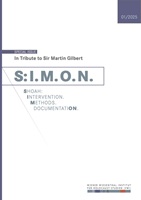Jewish Children and Teenagers Surviving the Last Deadly Months of the Holocaust in Bergen-Belsen
Jewish Children and Teenagers Surviving the Last Deadly Months of the Holocaust in Bergen-Belsen
Author(s): Verena BuserSubject(s): Political history, Social history, WW II and following years (1940 - 1949), Fascism, Nazism and WW II, History of the Holocaust, History of Antisemitism
Published by: Wiener Wiesenthal Institut für Holocaust-Studien
Keywords: Bergen-Belsen; Child survivors; Children's resilience; Adolescents in concentration camps;
Summary/Abstract: Opened in 1943, the Bergen-Belsen concentration camp near Celle, Germany, held at least 3,000 children and adolescents, most of them Jewish. In 1944, a process began in which thousands of prisoners died intentionally in Bergen-Belsen. Bergen-Belsen served first as an “evacuation camp” for prisoners from concentration camps near the front; from the summer of 1944. However, it also functioned as a transit camp for women and girls, many of them Polish, who were sent to subcamps for forced labour. Furthermore, it was used as a (cynically called) “rest camp” for prisoners who had been sent to concentration camps on Reich territory as sick and unfit for work. They died from deliberate neglect, as they were not cared for. In the last months of the war, between January and April 1945, some 80,000 to 90,000 people arrived at the camp. This article focuses on children’s experiences and their adaptation to camp life despite death, murder, starvation. The evaluation and analysis of these testimonies and interviews with child survivors, who report from the perspective of adults today, shows that children had a specific view of the concentration camp that differed from that of adults and, at the same time, helped the children to cope with everyday life in the camp. In the oral histories or eyewitness accounts of survivors, there are repeated references to the “quicker” adjustment of children and adolescents compared to older prisoners. Nevertheless, the memories of that time never left them. The testimonies of Jewish child survivors serve as crucial historical evidence, particularly in an era in which Holocaust scholarship faces challenges such as distortion, denial, and revisionism. At the time of writing, the world is at the eve of commemorating the eightieth anniversary of the end of the Second World War and the liberation of the camps. There are still a few Jewish child survivors of the Holocaust who went through Auschwitz, Bergen-Belsen, or other camps under German administration in Nazi-occupied Europe. At the end of the war, and on their way to a new life, they often had a double burden to carry. Their parents, often preoccupied with their own concerns, were survivors themselves. The children had survived the camps under the most difficult and horrible conditions, often marked by the loss and death of loved ones. The child survivors had witnessed death, starvation, and crime. Despite this burden, many of them showed great resilience and started families of their own. In all the concentration camps which belonged to the central administration Inspektion der Konzentrationslager (IKL, Inspection of Concentration Camps), there were minors among the prisoners, even in the very first camps that were established right after Adolf Hitler came to power in January 1933.2 The best-known example of a teenager who was a prisoner in a concentration camp is that of the German-Jewish girl Anne Frank from Frankfurt am Main. Her diary is a “cornerstone of the culture of remembrance” not only in the Federal Republic of Germany3 but also worldwide. It is a paradigmatic example of the persecution of children and young people under the Nazi regime. After the Frank family had been discovered in their hiding place in Amsterdam, the then fifteen-year-old Anne Frank was deported with her sister and mother via the transit camp Westerbork in the Netherlands to Auschwitz-Birkenau4 . As the Red Army advanced and the Auschwitz camp system was disbanded, more than 60,000 prisoners were evacuated to Germany on death marches by foot, in wagons, and by train. Countless Jewish and non-Jewish prisoners died on the way or were murdered by the guards, the killing machine, and the Birkenau staff, who arrived on German soil and continued the killing. Anne and her sister Margot died shortly before the liberation of the Bergen-Belsen concentration camp in April 1945. Like countless other Jewish children and young people, Anne did not survive the Holocaust and was unable to bear witness to the atrocities, be it in a diary or to the world. The life of children in Bergen-Belsen is described below using the example of the Sternlager (Star Camp). This was a subcamp in which the Jewish prisoners were held hostage, and they lived there in a situation that was different to the other camps. The existence of these Jewish children on German territory was an exception, as the camps on German territory were made “Jew free” in October 1942. Against the background of the unfolding genocide of European Jews, being sent to a concentration camp meant for Jewish children and young people their temporary survival under inhumane conditions.
Journal: S:I.M.O.N. Shoah: Intervention. Methods. Documentation.
- Issue Year: 12/2025
- Issue No: 1
- Page Range: 88-102
- Page Count: 15
- Language: English

